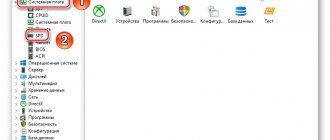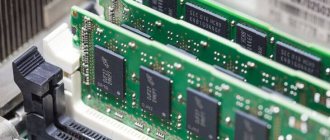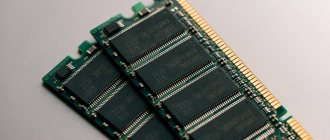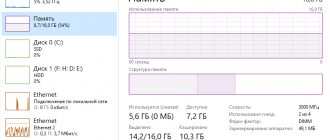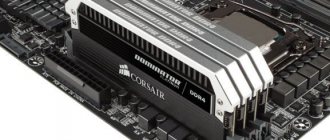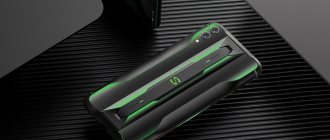- 23shared
- 1Facebook
- 22Twitter
- 0VKontakte
- 0Odnoklassniki
Computer performance is a combination of several factors, or better yet, the technical characteristics of hardware devices, among which the main role is played by the processor, hard drives and, of course, RAM or RAM for short. On a computer, RAM serves as a kind of intermediate link between the processor that performs all the calculations and the storage device - the HDD or SSD. The processes of all programs and the Windows 7/10 operating system itself are loaded into it, but if the volume of application data exceeds the capacity of RAM, the data is cached, for example, in the page file. But in any case, a lack of RAM will cause the computer to run slowly and applications to become less responsive. And on the contrary, the more RAM there is on a PC, the faster data exchange occurs, the faster the system, the more powerful applications you can run.
What are the main characteristics of RAM and why know them?
So, the more RAM, the better, and that is why users often install an additional RAM module on their PC. However, you can’t just go to the store, buy any memory and connect it to the motherboard. If it is chosen incorrectly, the computer will not be able to work, or worse, it will lead to the fact that the RAM will simply fail. Therefore, it is so important to know its key characteristics. These include:
- Type of RAM . Depending on performance and design features, DDR2, DDR3 and DDR4 modules are distinguished.
- Memory . The parameter is characterized by the amount of data that can fit in memory cells.
- RAM frequency . The parameter determines the speed of operations performed per unit of time. The bandwidth of the RAM module depends on the frequency.
- Timing . These are time delays between sending a memory controller command and its execution. As the frequency increases, the timings increase, which is why overclocking the RAM can lead to a decrease in its performance.
- Voltage . The voltage required for optimal operation of the memory stick.
- Form factor . The physical size, shape of the RAM stick, as well as the number and location of pins on the board.
If you install additional memory, it must have the same size, type and frequency as the main one. If the RAM is completely replaced, attention should be paid to the support of the replaced RAM by the motherboard and processor with only one nuance. If the PC uses Intel Core i3, Intel Core i5, Intel Core i7 processors, matching the memory frequency and the motherboard is not necessary, because for all these processors the RAM controller is located in the processor itself, and not in the northbridge of the motherboard. The same goes for AMD processors.
Information we can look at about RAM
RAM has several division branches:
- the first is volume, a fairly obvious characteristic. The more the better, but look at the processor and motherboard - they support the increase up to a certain ceiling;
- the second characteristic is type. An ancient SIMM, a slightly less ancient SDRAM... Well, this is unlikely, of course, although it is not excluded. And modern DDR standards - from first to fourth;
- and finally the memory frequency. Here, as in the case of processor frequency, the higher the better. However, again make sure that your processor runs at this frequency. If it doesn't start, it will be quite a shame.
So, let's start studying these signs.
How to determine the type and amount of RAM visually
Physically, RAM is an oblong board, most often green, with chips located on it. On this board, the manufacturer usually indicates the main memory characteristics, although there are exceptions. Thus, there are memory strips on which nothing is indicated except the name of the manufacturer. If there are markings, it is not difficult to find out what RAM is installed on the PC. After completely turning off the computer and removing the system unit cover, carefully remove the memory module from the slot (the latter may not be necessary) and carefully study the information on the white sticker.
A number with the GB prefix will indicate the memory capacity, a number with the MHz prefix will indicate the frequency, numbers in the XXXX format will indicate timing, V will indicate voltage. But the type of RAM (RIMM, DDR2, DDR3, DDR4, etc.) is not always indicated. In this case, you should pay attention to the bandwidth, usually denoted as PC, and check it according to the standards specification in the same Wikipedia on the page ru.wikipedia.org/wiki/DRAM. The number after PC usually indicates the DDR generation, for example, PC3-12800 indicates that the PC has DDR3 memory installed.
Designation and markings on the RAM stick
In general, there is usually always a sticker on the memory stick with all the necessary information: manufacturer, memory size, operating speed, memory type, timings.
I’ll look at the example of one of the planks (so that they are all similar, and having disassembled one, you can figure out the rest without me ☝).
2GB 1Rx8 PC3-12800S-11-11-8B2 - what do these numbers mean:
- 2GB - amount of memory (the more, the better ☝);
- 1Rx8 is a single-sided memory rank (for example, 2Rx8 is double-sided). Often this information is not indicated at all, and many do not pay attention to it;
- PC3-12800 - the throughput of the bar (roughly speaking, the speed of operation). By the way, this memory stick does not indicate its type (DDR3, for example), but PC3-12800 indicates that it is a DDR3 type (if there was a PC2... then it would be a DDR2 type);
- 11-11-B2 - timings (this is a big topic, and I won’t cover it in this article, I’ll just say that they affect the performance of your memory).
Markings on the memory stick
By the way, using the table below, you can convert the designation PC3-12800 into the standard name - DDR3-1600 (which, by the way, is also sometimes indicated on RAM sticks).
Standards Specification Table (DDR3)
Standard name Bus frequency, MHz Effective (double) speed, million transfers/s Module name Peak data transfer rate with a 64-bit data bus in single-channel mode, MB/s
| DDR3‑800 | 400 | 800 | PC3‑6400 | 6400 |
| DDR3‑1066 | 533 | 1066 | PC3‑8500 | 8533 |
| DDR3‑1333 | 667 | 1333 | PC3‑10600 | 10667 |
| DDR3‑1600 | 800 | 1600 | PC3‑12800 | 12800 |
| DDR3‑1866 | 933 | 1866 | PC3‑14900 | 14933 |
| DDR3‑2133 | 1066 | 2133 | PC3‑17000 | 17066 |
| DDR3‑2400 | 1200 | 2400 | PC3‑19200 | 19200 |
DDR4 - standards specification
*
DDR2, DDR3, DDR4 how to distinguish?
Quite often you hear questions about how to distinguish between different types of memory, for example, DDR2, DDR3, DDR4 (especially novice users are afraid when buying additional memory for their PC).
In general, the simplest option is to use and read the markings on the memory stick. If there are no markings on the stick itself, my advice is to avoid purchasing such memory altogether!
Also, before buying memory, check which die is suitable for you (more on this above), look at which one you already have on your PC (and select an analogue).
To help!
An article on how to choose the right RAM for a laptop
In addition, please note that different types of brackets (the same DDR2 and DDR3) also differ in geometry! The photo below shows a ruler and strips of different types.
Ddr1 DDR2, DDR3 - how to distinguish the strips (size in cm)
By the way, the memory bar for a laptop is shorter than for a desktop computer. It is usually designated SO-DIMM (for PCs simply DIMM).
Please note that the bar from the laptop through the special. The adapter can be put into a computer, but you won’t be able to put a bracket from a PC into a laptop - it simply won’t fit into the compact body of the device!
Memory sticks for PC and laptop
How to find out how much RAM you have using Windows tools
Above, we briefly discussed how to determine what RAM is on a computer by visually inspecting the module; now let’s find out how to find out its volume using the operating system. Windows 7/10 has a built-in utility for this, msinfo32.exe . Press Win+R to open the Run dialog box, enter the command msinfo32 and press Enter.
In the main section of the system information window that opens, find the item “Installed random access memory (RAM)” and see its volume in GB.
Instead of the msinfo32.exe utility, you can use another built-in component to determine the amount of RAM - DirectX . It is launched with the dxdiag , the amount of memory is displayed in megabytes on the first “System” tab.
Simple inspection
The most obvious way to find out your computer's RAM type is without even turning it on. In many cases, it allows you to determine the required characteristics with absolute accuracy, but it also has a number of significant disadvantages. You will have to open the computer - for some this is a significant stopping factor. The sticker on the memory stick may not correspond to reality, be insufficiently informative, as with many not very well-known manufacturers, or be completely absent. However, this method can be used quite well.
- Remove the side cover of your computer.
Note : There is another labeling standard. Pay attention to the picture above. In brackets on the sticker you can see the inscription PC3 10600. These are nothing more than encoded characteristics, excluding volume. PC3 - DDR3, 10600 - frequency. To get the usual value in megahertz, you need to divide this number by 8. You get the familiar 1333.
You can also add that the type of memory can be determined by the location of the contacts and cutouts on the bottom edge, but this is a rather complicated and unnecessary method, so we will bypass it.
Third-party programs for determining RAM parameters
The information provided by the standard Windows utility is sparse. It allows you to find out how much RAM is on your computer, but does not display its other important characteristics. If you need more data, it is better to use special programs. The most famous of them is, of course, AIDA64 Extreme Edition . Information about memory in this program is contained in the Motherboard - SPD menu and includes such characteristics as module name, size and type, frequency, voltage, timing and serial number.
You can also view the RAM using the Speccy from the developers of the popular CCleaner cleaner. General information about RAM in the program is available on the main “Summary” tab, and additional information is available on the “RAM” tab. This includes volume, type, timing, channel mode, frequency and some other, less important information. Unlike AIDA64, the Speccy application is free, but it shows less information.
To view the main memory characteristics, we can also recommend the CPU-Z . The necessary information is located in the “Memory” tab. It includes the type, size, channel mode, ratio of the system bus frequency to the RAM frequency and other additional information. Like Speccy, CPU-Z is free, but it does not support the Russian language, which, however, is not so important.
And finally, we recommend one more program for viewing information about RAM. It's called HWiNFO64-32 . Externally and functionally, it is somewhat reminiscent of AIDA64 and at the same time CPU-Z. On the “Memory” tab, the program shows the module type, capacity in megabytes, channel mode (one-, two- or three-channel), clock frequency, timing and other additional information. HWiNFO64-32 is free, the interface language is English, which, as in the case of CPU-Z, is not fundamentally important.
- 23shared
- 1Facebook
- 22Twitter
- 0VKontakte
- 0Odnoklassniki
On Windows 11 or Windows 10
You can find out the type of RAM in the task manager on the “Performance” tab. To the right of the “Memory” heading, its capacity, speed and how many slots it occupies are displayed.
There are three ways to get to the desired page:
- Keyboard shortcut Ctrl + Alt + Del .
- Keyboard shortcut Ctrl + Shift + Esc .
- Search for “ Task Manager ” and open the “Performance” tab.
If this information is not enough for you and there is no way to install third-party programs, you can use the Windows Management Instrumentation command-line (wmic) command line utility.
You need to launch a command prompt window by typing “ cmd” . In the command prompt window, type:
wmic MemoryChip get
You will see many properties, including the following: MemoryType, Capacity, Speed, Configuredclockspeed, DeviceLocator, FormFactor, Manufacturer, Serialnumber, Partnumber.
- MemoryType shows a number that corresponds to the type of RAM. 20 means DDR memory, DDR2 - 21, DDR3 - 24, DDR4 - 26. Sometimes 0 may be displayed, in which case you can look at the value in “SMBIOSMemoryType”.
- Capacity of RAM in bytes. A value like 8589934592 corresponds to a memory capacity of 8 GB.
- Speed is usually between 800 and 3200 .
- Configuredclockspeed shows what speed the memory is currently running at.
- DeviceLocator indicates which slot the memory sticks are installed in.
- FormFactor refers to the physical form of the memory module. On personal computers the value for DIMM slots is usually 8, in laptops for SODIMM is 12.
- Manufacturer the company that produced the memory. Sometimes it is not detected.
- Serialnumber shows the serial number, which can be useful when contacting the manufacturer in case of problems.
- Partnumber means the number of a specific memory stick, with which you can search for it in stores to purchase an identical module.
Visual method
This method is used even before the board is installed in the slot. Full information is visible on the sticker, you just need to be able to read it.
Almost always these are the following inscriptions:
- volume;
- rank - memory created by one or all memory modules;
- RAM type;
- throughput;
- manufacturer's name.
These data are not always indicated, and sometimes they are only partially indicated. In this case, manufacturers use another method to prevent erroneous installation. These are the pad size and cutout configuration. Therefore, it will not be possible to insert DDR2 memory into a slot intended for DDR3.
For those who do not know how to find out the model of RAM that is in the computer, the Internet will be a help. This could be the manufacturer’s website, if it is mentioned on the bar, or search engines, in which you need to type in the information that you managed to obtain.
Operating system tools
The simplest of all methods. However, it is also the most limited. If it is enough for you to know only how much RAM you have, this is for you, because on its own the system cannot determine either the frequency, much less the type of RAM. But this is only about Windows - macOS can do more.
In the case of macOS:
- Click the apple at the top and select About This Mac from the menu.
If you have Windows, then everything is not so smooth:
- Right-click the Start menu and select System from the menu.
The processor and the system bit capacity are indicated there, but very little is written about memory - only the volume. So you won't have much fun.
